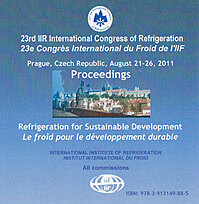
IIR document
Effect of particle volume fraction on spray heat transfer using Al2O3-water nanofluid.
Number: pap. ID: 197
Author(s) : CHANG T. B., SYU S. C., YANG Y. K.
Summary
The spray cooling is a very effective heat transfer mode. Using a 35-nm Al2O3-particle–water nanofluid as working fluid, the effects of particle volume fraction on the spray heat transfer performance were investigated experimentally in this study. The tested surface was a flat, horizontal and circular heated surface. The tests were realized for the following ranges of the governing parameters: the nozzle orifice diameter is 2.3 mm and the distance nozzle-to-heated-surface was set to 17 mm; the spray mass flow rate varies from 0.021 to 0.056 kg/s. In addition, four different particle volume fractions (0, 0.001, 0.025, and 0.05 Vol%) were specially prepared to determine the proper particle volume fraction. It is shown that the optimal heat transfer performance is obtained using a particle volume fraction of 0.001 Vol%. After finishing spray cooling experiments, SEM was used to analyze the compositions of various heated surfaces for different particle volume fractions. A few Al-elements were detected on heated surface for 0.025 and 0.05 Vol% but no Al was found for 0 and 0.001Vol%.
Available documents
Format PDF
Pages: 9 p.
Available
Public price
20 €
Member price*
Free
* Best rate depending on membership category (see the detailed benefits of individual and corporate memberships).
Details
- Original title: Effect of particle volume fraction on spray heat transfer using Al2O3-water nanofluid.
- Record ID : 30001630
- Languages: English
- Source: Proceedings of the 23rd IIR International Congress of Refrigeration: Prague, Czech Republic, August 21-26, 2011. Overarching theme: Refrigeration for Sustainable Development.
- Publication date: 2011/08/21
Links
See other articles from the proceedings (569)
See the conference proceedings
Indexing
-
Experimental analysis of local condensation and...
- Author(s) : HASAN A., MIYARA A.
- Date : 2024/07/17
- Languages : English
- Source: 2024 Purdue Conferences. 20th International Refrigeration and Air-Conditioning Conference at Purdue.
- Formats : PDF
View record
-
An application of nanotechnologies in refrigera...
- Author(s) : ZHELEZNY V. P.
- Date : 2014/08/02
- Languages : English
- Source: 11th IIR Gustav Lorentzen Conference on Natural Refrigerants (GL2014). Proceedings. Hangzhou, China, August 31-September 2, 2014.
- Formats : PDF
View record
-
Effect of thermo-physical properties on wall su...
- Author(s) : AKAI S., SUGIMOTO K., ASANO H.
- Date : 2024/07/17
- Languages : English
- Source: 2024 Purdue Conferences. 20th International Refrigeration and Air-Conditioning Conference at Purdue.
- Formats : PDF
View record
-
Effect of inclination angles on the heat transf...
- Author(s) : KIM W. H., KIM M. H., CHOI J. C., et al.
- Date : 2002/12/04
- Languages : English
- Source: Green breeze from Asia: frontiers of refrigerants, heat transfer and system.. ACRA-2002. Proceedings of the Asian conference on refrigeration and air conditioning.
View record
-
A novel dehumidification system using zeotropic...
- Author(s) : LIU X., LIANG X., HUANG M.
- Date : 2019/08/24
- Languages : English
- Source: Proceedings of the 25th IIR International Congress of Refrigeration: Montréal , Canada, August 24-30, 2019.
- Formats : PDF
View record
